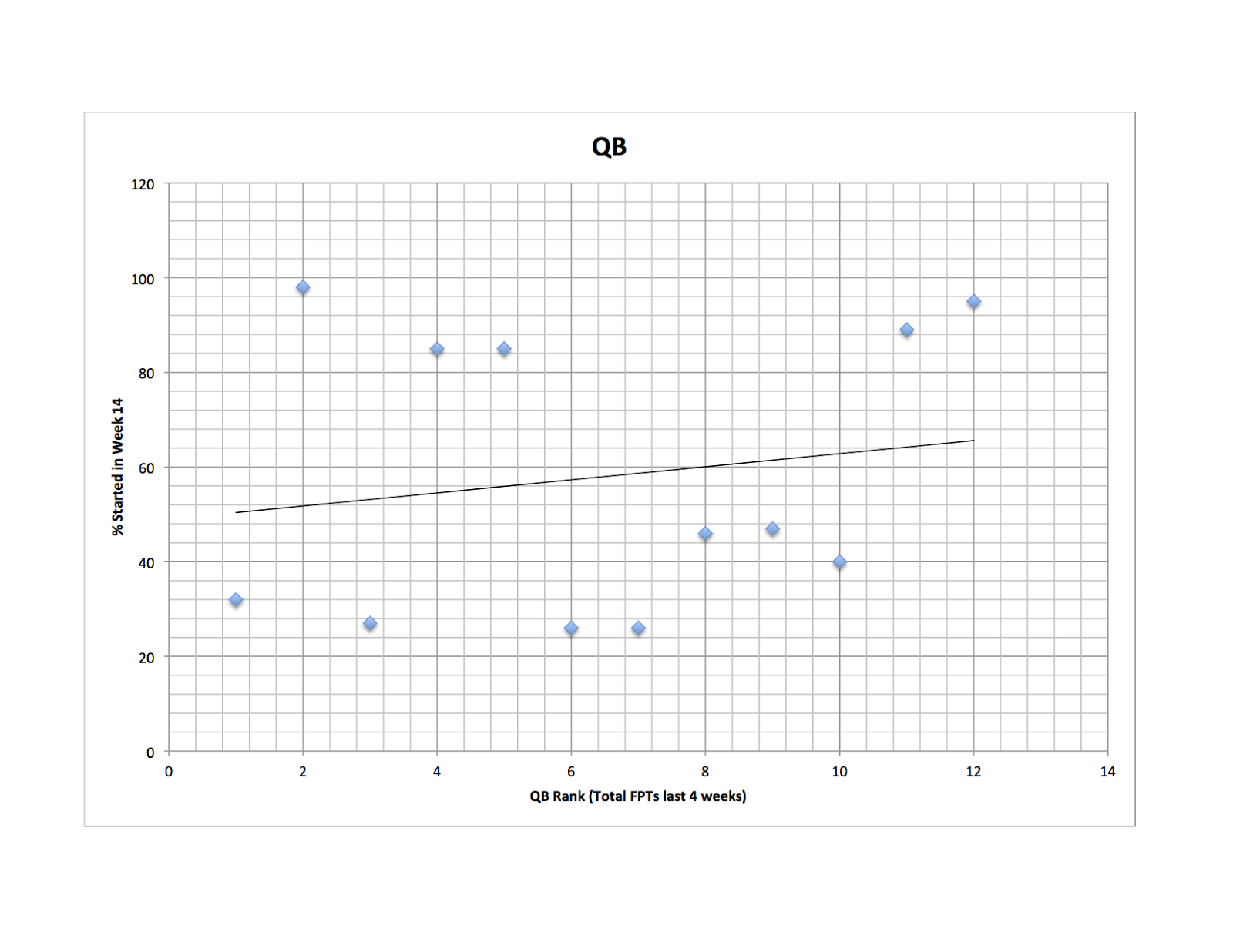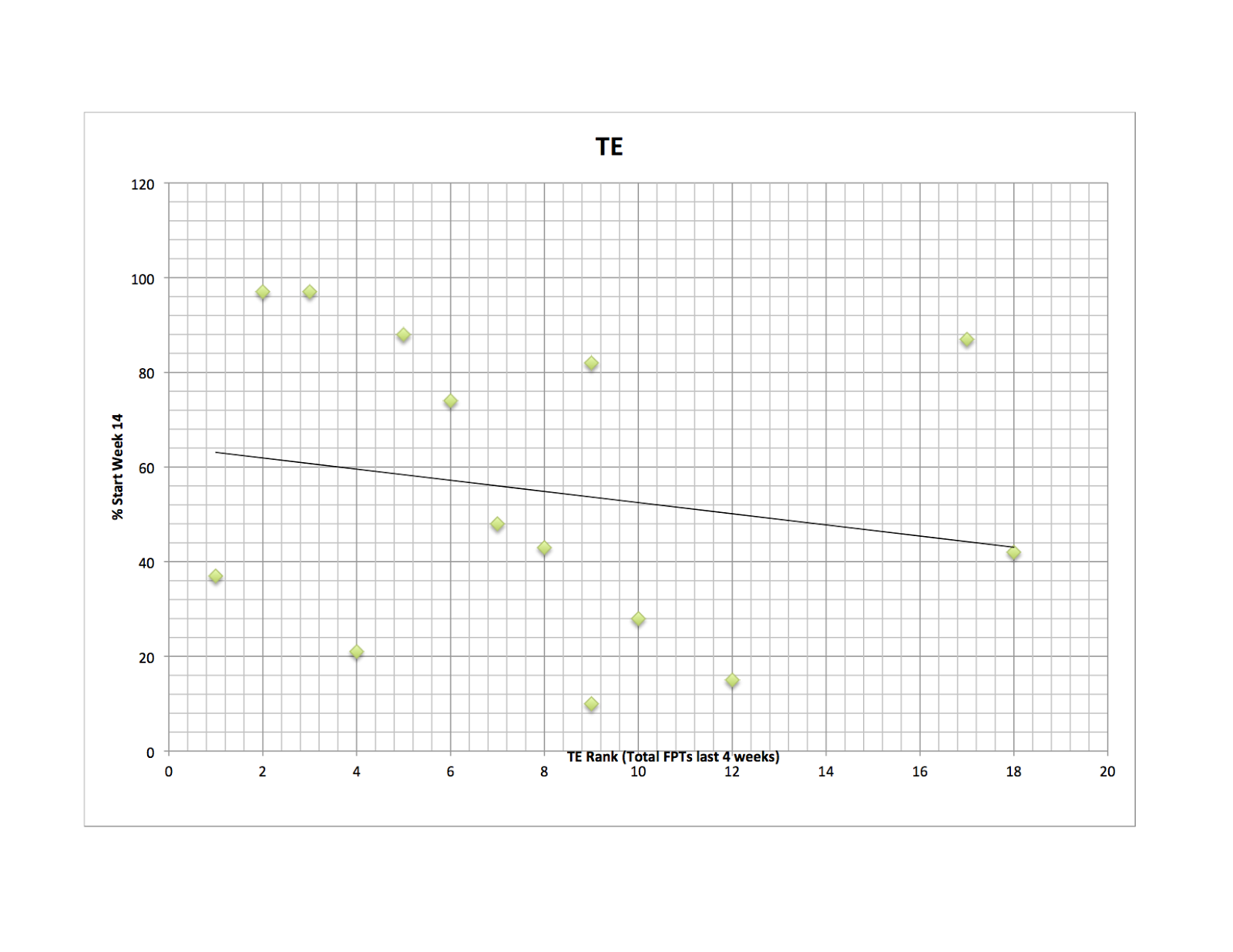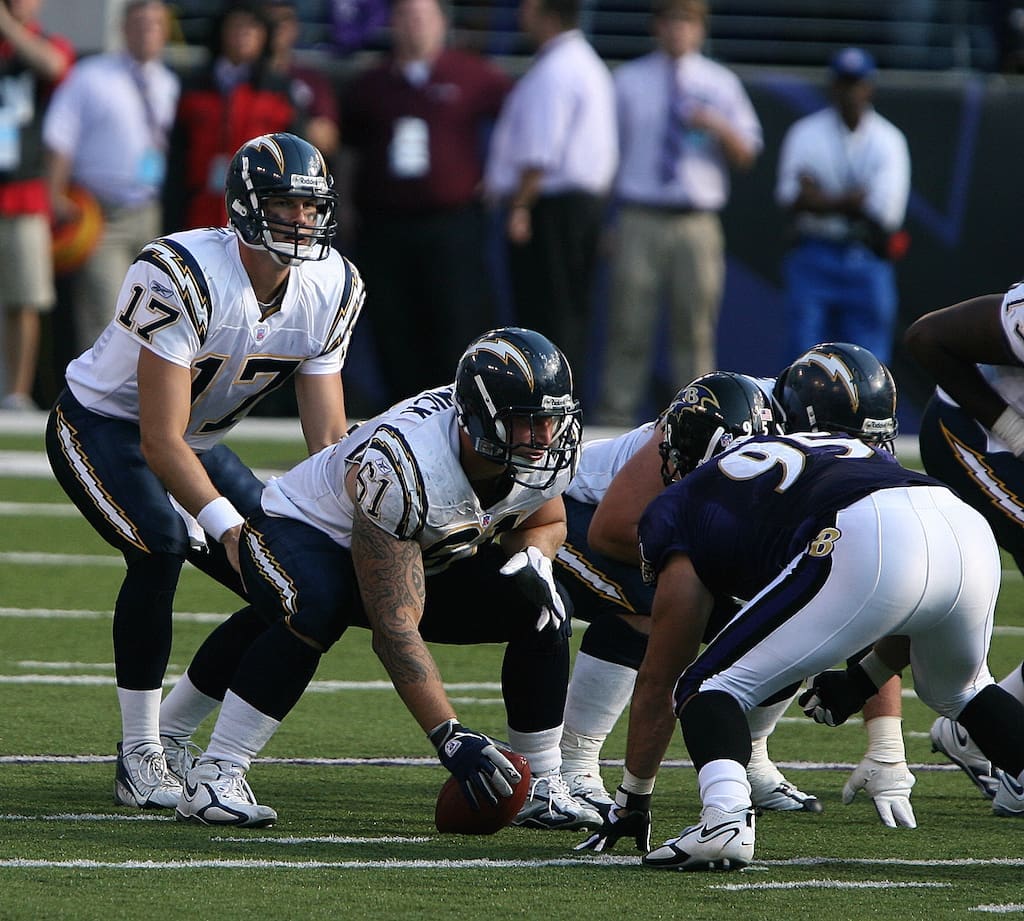We all fall somewhere on a risk continuum, but where? Dr. Renee Miller proposes that the answer lies in our fantasy football playoff rosters.
By Renee Miller
People are by nature self-reinforcing. We behave in ways that are consistent with and shore up our underlying beliefs and values. I like the idea that you can learn a lot about a person from simply asking their favorite TV shows or movies.
Many aspects of our personality are reflected in our media choices. I’m a neuroscientist, not a psychologist, so I’m not going to psychoanalyze anyone’s choices (mine are Breaking Bad, Modern Family, Friday Night Lights, The West Wing, and Survivor), but everyone can get a good feeling for a person’s sense of humor, how serious they are, etc. from this short list.
However, there is at least one key element of personality that probably can’t be ascertained by this simple question: Are you a risk taker?
Do you take chances in your life or do you take a safe, steady, and conservative path? We all fall somewhere on this risk continuum, but where? I propose that the answer lies in our fantasy football playoff rosters.
Are you a fantasy football risk-taker?
How you approach the playoffs actually reflects not only your lifelong study of the game, analysis of the individual player and team statistics over the course of the season, or the amount of research time you’ve put into this week’s matchups, but also your personality. In the end, many decisions about whom to start and whom to sit will come down to how comfortable you are with taking risks.
Fantasy Football Playoffs & Anxiety
The fantasy playoffs are a time of high anxiety, where every decision is magnified because it could be your last. Our rosters and matchups are on our minds constantly. The pressure to make the right choices or go home empty handed affects our brains and our bodies, not unlike the pressure some of us feel before public speaking, but longer lasting.
The main chemical that mediates the anxiety response in the brain is called norepinephrine (NE). It’s considered an arousal hormone or neurotransmitter for its ability to increase the sensitivity of the cells of the brain to input. The heightened awareness and perception caused by spikes in NE is manifest during everyday life through enhanced performance. A little bit of test anxiety or fear of public speaking–those butterflies in your stomach and sweaty palms–are the result of circulating NE and the more famous stress hormone, cortisol, and generally represent an adaptive response to help you succeed in your task. I discussed the role of NE in possibly enabling clutch performances, such as Tom Brady’s game-winning extravaganza last weekend, a few weeks ago at rotoviz.com. It appears, after facing Philip Rivers and Ryan Mathews in one league Thursday night, that I am in need of such a clutch performance.
In the fantasy playoffs, however, the anxiety isn’t transient.
It can last weeks–at least we hope it does! This chronic fluctuating awareness that our whole season comes down to the decisions we make this weekend and next probably stimulates levels of NE and cortisol that exceed the optimal performance-enhancing levels. No one has ever measured these chemicals in high-stakes fantasy players, but I’d bet on them being higher than normal this time of year.
[Read More: Poker Lessons For Fantasy Football]
Unfortunately, at chronically high levels of these stress hormones, performance can actually decline.
The brain is operating at such a highly tuned state that processes that were previously automatic (e.g. thought patterns as well as motor skills like throwing a ball) are second-guessed. It’s like once you start to think hard about what it takes to ride a bike, you start wobbling all over the place.
Some of us cruised to the playoffs pretty stress-free while some fought an uphill battle to squeak in at the very end. All of us are now overthinking and second-guessing every decision we have to make. It’s the fantasy equivalent of choking, a term I’m not too fond of, but could be due to a loss of automation in motor skills when high NE causes the executive part of the brain to take over.
In an ironic twist, my quarterback in the aforementioned league is none other than Tony Romo.
I can see this high anxiety, over thinking mind-set play out through two different biases depending on your risk taking personality:
First, we can ignore high upside new guys like Ladarius Green, Cordarrelle Patterson, and Nick Foles in favor of old fantasy standbys like Jason Witten, Mike Wallace, and Tony Romo. This is the safe play. You go with experience, consistency (over many years, not necessarily this season), the guys that have been there and come through for their fantasy owners before. You know them.
Second, we can go the risky route and play the hot hand. We start the high upside, tantalizing new fantasy toys like L. Green and C. Patterson, leaving those standbys well, standing by. The thrill of knowing they could put up a zero, like Green did last week (and nearly did Thursday night), or 25 PPR fpts like Patterson did, and betting on the 25 is why you play fantasy in the first place. You dig the possibilities.
It seems logical that we should simply be starting the best players at each position, regardless of how many years they’ve been among the best players at their position. We’ve all seen the blind Player A vs Player B scenarios that suggest Matt McGloin makes a better fantasy play than Drew Brees or something incredulous like that. Don’t worry, I’m not going there. I’m not interested in convincing you to start one guy or another. Instead what I did was plot players’ position rank over the last four weeks against the percent of leagues that started those players in week 14, the first week of the fantasy playoffs. This gives us an idea of how attached we as a fantasy community are to starting underperforming known quantities (safety bias) and how often well performing players are left on the bench in the playoffs.
(Notes on the analysis: The fantasy point totals are from a Yahoo PPR league I’m in. Although the week 14 points are included in the rank, you did not have these numbers when making your lineup decisions. I’m not sure the ranks change terribly significantly, but they would have been different heading into week 14. I used the last four weeks point totals because so much changes over the whole season due to injuries, etc. For QB and TE, I used the top 12 players, with a couple of others whose start percentage stuck out to me, that I’ll highlight below. For RB and WR, I selected guys from a large range of ranks. There were many top 20 players at these positions that are 100% started–it doesn’t really help our discussion to show that everyone starts Jamaal Charles or Calvin Johnson, so those kind of situations are not shown here. One more caveat with start % is that players may be rostered by teams not in the playoffs or on bye and therefore not making lineup adjustments. I’m guessing anyone ~85% started was started by everyone who owned him).
Ideally, we should see a nice negatively sloped linear relationship between % started and rank, with the highest ranked players being started the most often. For WR this is generally the case. At TE, you see the nice correlation for the top 12 guys, it’s the two extra points I included that skew the line. For the other positions, particularly RB and QB it is definitely not ideal. In more detail…
(click on the graphs to open them in a new window)


Quarterback: The notable outliers here were that only 32% of people started Josh McCown, the number one fantasy quarterback over the past four weeks. Ben Rothlisberger, started in 27% of leagues, is the number three quarterback. Alex Smith, Ryan Tannehill, Carson Palmer, Philip Rivers, and Andrew Luck are all top 10 quarterbacks who were started in fewer than 50% of leagues last week. (Note: Nick Foles and Russell Wilson both had bye weeks during the total fantasy point calculation period, so they were not in the top 12 total, but were #5 and #10 respectively in average fantasy points over that period. Both were started in over 60 percent of leagues).


Tight End: Many people stream the TE position, which might explain why the best TEs are consistently highly rostered. The trend looks promising, but a closer look reveals that the #1 (Charles Clay), 4 (Vernon Davis), and 9 (Heath Miller) TE were started in fewer than 40% of leagues. Meanwhile, the #17 (Witten), 18 (Martellus Bennett), and 20 (Jared Cook) were started in 87%, 42%, and 27% of leagues last weekend. To be honest, it was easy to miss at TE last weekend if you played the matchups.


Running Back: Many of the 20 top ranked RB are nearly 100% started. Since it’s possible to start three RB in most leagues, however, we can reasonably expect that the start % for the top 30 ranked players should be much higher than the start % for those ranked over 30th over the past four weeks. I’ve excluded anyone who’s fpt total over that period would be influenced by their own injury or a bye week. The straight line indicates that many highly ranked players aren’t being started enough, and many lower ranked players are being started too often. Most notable? Shane Vereen, the #3 RB over the past four weeks was started in only 52% of leagues. Bobby Rainey was another player, ranked #6, started in only 41% of leagues last week. On the other hand, Alfred Morris, who is ranked #37, was started by 80% of fantasy GMs. His first round draft status is keeping him in the starting lineups of most of his owners.


Wide Receiver: The trend is good here. We are for the most part starting the best WR in the playoffs, and again, I’ve excluded the obvious 100% players. There are notable exceptions though. Most leagues can start three or four WR, so anyone ranked in the top 30 again should be started with high frequency. Here are the names and ranks of some highly ranked, low started outliers: Cordarelle Patterson #23, 11%; Dwayne Bowe #19, 53%; Ace Sanders #25, 0%, Michael Floyd #10, 54%; Rod Streater #11, 8%. On the flip side, those ranking over 40 but started in more than 20% of leagues: Riley Cooper #62, 45%; Hakeem Nicks #52, 36%, DeSean Jackson #50, 86%; James Jones #41, 37%, TY Hilton #55, 53%.
I didn’t point out which decision worked out better in those cases where there was deviation from the expected start %. For me to say, “See you clearly should have started that guy because he scored 30 fpts last week” is ridiculous. You can find examples on both sides, which is why I highlighted L. Green and C. Patterson above. Not every highly ranked, highly skilled player will deliver high fantasy scores every week. However, taking advantage of the past performance data available on your fantasy site may open your eyes to consistent good performances in your scoring system that you might have overlooked.
We tend to see what we want to see and hear what we want and expect to hear. It’s our Confirmation Bias, a topic I wrote about extensively in my book, Cognitive Bias in Fantasy Sports: Is your brain sabotaging your team?“. It doesn’t matter how many articles you read or how many podcasts you tune in for, not all the stats and facts we come across make the same impact on our neural processing networks. One way to think about it is that beliefs that we’ve held for a long time are readily reinforced by outside data, whereas those that are newer are resistant. So recent standout performances by Rainey or Clay just don’t register as strongly as details of Witten’s or Wallace’s last big games do. It’s part of how our brains subconsciously reinforce our beliefs and therefore, behaviors.
The Confirmation Bias works with heightened anxiety and your risk taking personality to ultimately sway your decisions about whom to start and whom to bench for your all-important playoff matchups. If you play it safe in the stock market, with your restaurant/food choices and wardrobe selection, you are probably also going to field a pretty steady and conservative fantasy playoff team. It’s a team that no one can really fault you for, isn’t going to light the world on fire, but will probably come close to it’s median projection. If you love to chase the next hot stock, are first in line at the new club, drive fast and frequently “take your chances” you will find your starting roster full of high upside and recently hot NFL players. You are swinging for the fences-you’ll win big or lose trying. You’ll have fun cheering for this squad of players the casual fan has never even heard of.
Both strategies are clearly in effect, as the graphs above indicate. Is one better than the other? This would require a more careful analysis than I’ve done, but I didn’t find a clear trend at any position for the safe choice being better or worse than a risky choice. There is a trend toward starting the “safer” players, regardless of their rank, it’s just not clear that if you do so you’ll be let down in terms of fantasy production. Sometimes you will, sometimes you won’t. They are old standbys for a reason.
Ultimately, the potential for reward and the fear of losing it all weighs heavy on our minds. We might be operating at a level slightly past optimal on the NE continuum. Yet the decisions must be made. My compromise, since I gauge my risk taking personality to be slightly higher than average, is to add one or two high risk/high reward players to a very solid core squad. A last thing to factor in is your opponent. In my biggest money “home” league-not the one above- I’m facing the number one seed (my brother) this weekend and am a huge underdog. It makes me a little uncomfortable but I will probably roll out a much higher ceiling/lower floor team than I’m used to against him. I won earlier in the year, handing him one of his two losses, but that was in his weakened bye-week state. To win now, I might need a couple of trick plays. One I considered-and thankfully rejected-was Jacob Tamme. I made it to the playoffs with a good team, there’s no need to go off the deep end. Keep reminding yourself of that, because if you’re like me, your brain is going to keep coming up with these possible scenarios non-stop. Good luck this weekend, whether you stick to the straight and narrow or take a flying leap of faith.
Dr. Renee Miller is on faculty of the Brain and Cognitive Sciences Dept at the University of Rochester, author of Cognitive Bias in Fantasy Sports: Is your brain sabotaging your team? She writes regularly for rotoViz.com and RotoWire.com about fantasy football and daily fantasy NBA. Dr. Miller’s work can also be found on The Athletic, RotoWorld, and ESPN. Her book can be purchased from https://gumroad.com/l/
ukFOv
Featured Photo Credit: Keith Allison/Flickr C.C. 2.0

